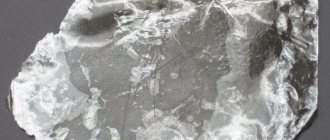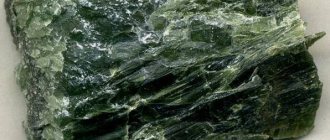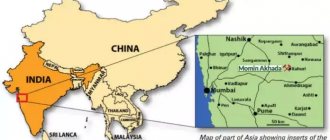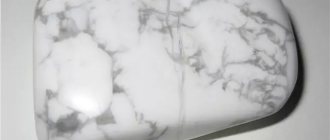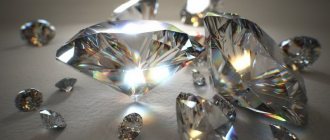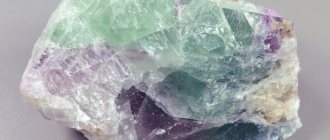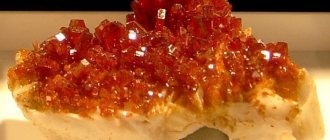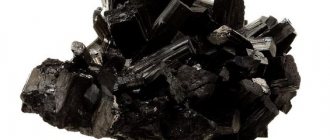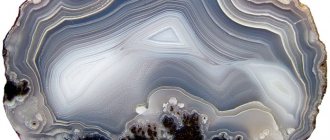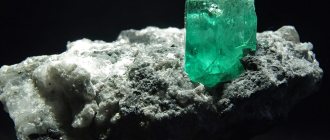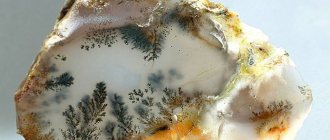origin of name
The name is from the Greek (auge) - shine - due to the strong shine on the cleavage planes (Werner, 1792, after Dana, 1892).
The name augite combines a series of isomorphic compounds with the following limits of elemental content (in formula units): Ca 0.36–0.84 (Mg, Fea+) 0.70–1.00 Si 1.76–2.00 Na 0.00– 0.14 (Al, Fe3+, Ti) 0.00–0.30 (Al, Fe3+, Ti) 0.00–0.24 (Mg, Fe2+) 0.20–0.64
Crystalline aggregate
Areas of application of augite
Augite is a common mineral on Earth, containing approximately 4% in the crust. The stone is neither precious nor semi-precious. It is considered ornamental. However, due to its unusualness (it sparkles even in its raw form) and variety of colors, it is a welcome guest in collectors' collections.
The most beautiful and rare stones go to jewelers. Due to their fragility, they are most often processed into cabochons, inserted into rings, and made into beads and bracelets. Inexpensive metals are mainly used as frames - silver, cupronickel and others.
The cost of augite is low, so it is never counterfeited - this is not rational. The cost of products and jewelry with it varies greatly:
- The bracelet costs about 10-20 dollars.
- Beads – 20-30 dollars.
The cost of souvenir products, for example, boxes, can start from 10 and reach up to 100 dollars, but craftsmen often increase the price, citing the naturalness of the mineral and handmade work.
Black-green augite gained some popularity among all kinds of sorcerers. Love potions are made from its powder.
Jewelry with augite and souvenirs made from the sparkling stone are most common in Italy; it is considered a symbol of the country. It is there that it is also set in both gold and platinum.
Chemical composition
Changeable; calcium oxide (CaO) 16-20%, magnesium oxide (MgO) 11.5-17.5%, ferric oxide (FeO) 5-10%, iron oxide (F2O3) 1.5-8%, aluminum oxide (Al2O3 ) 4.5–7.8%, titanium oxide (TiO2) 0.2–1.25%, silicon dioxide (SiO2) 46–50.5%.
According to other sources, chemical fluctuations in the contents of components (in%): CaO 21.0-8.9, MgO 24.43-0.14, FeO 31.5-1.74, Al2O3 9.6-0.3, SiO2 55 .1–46.1, Fe2O3 7.1–0.2, Na2O 1.9–0.00, TiO2 5.7–0.1, K2O 0.54–0.00
The upper limit of calcium content in a formula unit adopted here is Ca0.84; the lower limit is Ca0.36. Calcium-rich augites are close in composition to diopsides - hedenbergites, calcium-poor - to pigeonites. The boundary of augite with fassaite corresponds to Al0.24 in position T, the boundary of augite with omphacite and aegirine-diopside corresponds to aegirine-hedenbergite - NaO0.14. Calcium-rich augites - ferrogedenbergites - are characterized by a high content of Na2O (up to 2%), Al2O3 (up to 9-10%) and TiO2 (up to 5-6%), all magnesian augites have a high content of Cr2O3 (up to 2%). In addition to the main components, augites usually contain a large number of trace elements.
Price, storage, care
Since there is no shortage of this mineral in nature, the products are inexpensive. If they ask for a high price, they justify it by saying that the stone is natural. Collectors can buy a piece at an inflated price if it is unique. A crystal measuring 5x8 centimeters can cost either 500 or 5 thousand rubles.
Exclusive products are valued for their artistic processing. An oval brooch or ring without a frame can be found for 700-1000 rubles. A bracelet made of beads without artistic processing - for the same amount.
Important!
It is advisable to store jewelry in a separate box so that different stones do not touch. It is not difficult to care for: regularly, but not often, polish with suede or thin felt.
Varieties
Augite is conventionally divided according to the content of Fe and Mg (in at.%) into the following varieties: Magnesian augite - magnesian augite Mg 45-70, Fe 0-10. Augite (actually) - augite Mg 30-60, Fe 10-40. Ferroaugite - ferroaugite Mg 10-40, Fe 30-60. Ferrohedenbergite - ferrohedenbergite Mg 0-10, Fe 45-70. * Fe = Fez+, Fe3+, Mn, Ti. The names magnesian augite and ferroaugite are given based on the contents of Mg and Fe, which are greater than in augite itself; ferrogedenbergite - due to a higher iron content than hedenbergite.
According to the Ca content, these varieties include calcium-poor augite and ferroaugite (Ca0.36-0.6) and calcium-rich magnesian augite, augite proper, ferroaugite, ferrogedenbergite (CaO0.80-0.84 in the formula unit). Since the boundaries between these varieties are determined only by chemical composition, and other properties are not clearly expressed, they are not described separately. The literature also describes poor and aluminum-rich augites, sodium, titanium, chromium augites - ferrogedenbergites; all of them do not even have conventional boundaries with the main varieties.
Augite and the signs of the zodiac
Astrologers consider Augite to be universal regarding compatibility with the signs of the zodiac:
- For Aries , Augite will become a kind of organizer; he will teach them punctuality and accuracy, keep promises and not put off their plans for later. The stone will also help Aries improve their health, especially their psychological side, which suffers the most in this fire sign.
- Hardworking and passionate about what they do, Taurus often, due to their line of work, have to communicate with a large number of people, not all of whom feel sincere sympathy. Augite will become a reliable protector for representatives of this zodiac from human envy, meanness, hatred, self-interest and hypocrisy.
- Geminis , outwardly strong and independent, in their souls, as a rule, always doubt and worry about every little thing. The sparkling mineral will make them stronger in spirit and help them believe in their own strength.
- Cancers , having made friends with Augite, will get rid of many health problems or completely forget about them. The physical condition of the body will significantly improve, and the nerves will also become “iron”.
- For Leos, the stone will help them survive difficulties, come to terms with changes, not give up when it seems that everything is lost, no matter what, raise their heads high and start life from scratch.
- Virgos with Augite will feel irresistible, they will begin to attract glances and enjoy special attention from the opposite sex. They will be able to decide on their desires, break off existing relationships for the sake of a new feeling, or, conversely, take them to the next level, for example, create a full-fledged unit of society.
For all zodiac signs, Augite activates the best aspects of character and smoothes out shortcomings, which will have a positive impact on their lives.
- Libras are always friendly and ready to help anyone in need. The sparkling mineral will ensure that their efforts are noticed, and their kindness will be returned a hundredfold.
- For Scorpios , irritable and nervous by nature, the stone gives calmness, endurance and wisdom.
- All Sagittarians , as a rule, are very talented, but natural shyness does not allow them to develop. The stone will help this sign decide to appear before the world in all its glory, show it their creations and achieve well-deserved rewards.
- Capricorns understand the people around them - identify those who are truly sincere and “weed out” the hypocrites. They will also learn to communicate easily and naturally, which will make them the soul of any team, and will also help improve relationships in the family.
- Aquarius and Augite are perfect for each other. The stone has a positive impact on all aspects of the life of representatives of this sign. They will improve their health, become more successful in business, more energetic, calmer and more resilient, find love and be able to fulfill their innermost dreams.
- Pisces are dreamy people. Often they spend more time in a fictional world, make plans and achieve success there, but in reality they live by what “God sends.” Augite will push them into the real world and help them realize themselves in reality. At the same time, Pisces will not stop dreaming, but will begin to take concrete actions to realize their plans.
| Zodiac sign | Compatibility (“+++” – ideal, “++” – good, “+” – can be worn, “-” – not recommended) |
| Aries | + |
| Taurus | + |
| Twins | + |
| Cancer | + |
| a lion | + |
| Virgo | + |
| Scales | + |
| Scorpion | + |
| Sagittarius | + |
| Capricorn | + |
| Aquarius | ++ |
| Fish | + |
5 / 5 ( 10 votes)
Crystallographic characteristics
Monoclinic system.
Symmetry class. Monoclinic-prismatic. 2/t.
Axle ratio. 1.1:1: 0.6; (5~105°.
Crystal structure
Simple chains of ions. The structure of augite is identical to that of diopside; the differences in the values of their unit cell parameters and interatomic distances are explained by the large difference in the content of Ca and Al. (Si, Al)—O chains are equivalent, more twisted than those of jadeite.
The main forms that determine the appearance of crystals: c (001), b (010), a (100), m (110), e (011), z (021), p (101), u (111), s (111 ), x (221).
Form of being in nature
The appearance of crystals . Short-columnar, needle-shaped, thick-tabular. Crystals are poor in shape. Usually there are no more than 4-8 (Goldshmidt, 1923). The crystals are usually prismatic, sometimes flattened along the a-axis or shortened along the c-axis. Well-cut crystals are rarely observed. Most often they occur as phenocrysts in volcanic rocks. Crystal sizes range from 0.001 mm (microlites in volcanic glasses) to 20 cm in gabbro-pegmatites. Dendritic and feathery forms are known, and for microliths - crescent-shaped, spiral-shaped and skeletal. The most perfectly formed and shiny are usually the a (100) and b (010) faces, less so - m (110). The prism faces of some crystals have vertical shading. The surface of many edges is uneven. Face sculpture and etching figures were not specifically studied.
Doubles. Twins intergrown along (100)), less often simultaneously along (100) and (011), as well as polysynthetic ones along (100) and (010) or (100) and (001) are common. Twin growths are known on different faces of the main individual with different axis directions from parasitic, also twinned, crystals. Twins of germination at an angle of 40 and 60°, as well as cross-shaped twins and tees of germination, were noted. Twins of (122) and (101) are rarely observed (Hinze, 1898).
Aggregates . Solid, granular, dense, needle-like.
A little history
Augite was found in the vicinity of the Saxon city of Freiberg. There, mineralologist A. Werner taught at the Mining Academy, who studied and described the gem at the end of the 18th century. He also gave the mineral a name that, according to some of Werner’s colleagues, does not suit the stone.
Mineral – Augite
The mineral was stored for a long time in the academy's storerooms. Having thoroughly examined the specimen under a magnifying glass and conducted a series of studies, the professor made a conclusion: despite the “dull” appearance of the specimen, give it the name “augite,” that is, “sparkling.” The stone was classified as a silicon group.
Physical properties
Optical
- Color green, black-green, brown-green to black; in lunar augites - yellow, red-brown.
- The line is greenish, brownish.
- Glitter glass
- Transparency. Opaque, translucent in thin chips.
Refractive indices
Ng = , Nm = and Np =
Mechanical
- Hardness 5.5-6.0. The microhardness of augite itself is 828 kgf/mm2. Fragile.
- Density increases with increasing iron content from 3.20–3.33 in magnesian augites to 3.65 in the most ferruginous ferroaugites
- Cleavage perfect according to (110); the separation along (100) is diallagic, less often along (001) malacolithic and at (010). Cleavage. Prism average; the angle between the cleavage planes is 87 and 89° (see figure - basal section with cleavage cracks).
- The fracture is uneven and conchoidal.
Chemical properties.
Only titanaugite completely dissolves in boiling hydrochloric acid.
Artificial acquisition
Augites were obtained from anhydrous glasses by slow crystallization of melts at 1 atm. Pure Ca-Mg-Fe2+ augites are synthesized from glasses under hydrothermal conditions, as well as during the crystallization of rock melts (basalts, olivine tholeiite, tholeiitic andesite and augite leucite) at pressures of 8-45 kbar. The resulting augites are characterized by a low calcium content (8.0–14.5% CaO). The most calcium-poor augites were obtained only from alkali basalt at 14–18 kbar; With increasing pressure, the amount of calcium in them may increase. During the crystallization of calcium-rich pyroxenes, with increasing pressure and temperature, the content of aluminum and sodium in them increases and the content of titanium decreases. Augites (from poor to calcium-rich) were obtained in the following systems: diopside–enstatite at 1 atm and 20 and 30 kbar, hedenbergite–ferrosilite at 25 kbar; augite - hypersthene at 810°.
Diagnostic signs
Similar minerals . Hornblende (amphibole).
Satellites. Fayalite, ferrogortonolite, ferruginous pigeonite, plagioclase, biotite, magnetite, pyrite, chalcopyrite, etc.
Mineral change.
Minerals of the augite series are quite stable. There are known cases of replacement of augite by salite and monoclinic amphiboles. Under post-magmatic conditions, augite transforms into various amphiboles. Complete pseudomorphs of augite of bastite (mica + serpentine) and fine-flaky mica are known. Its replacement with talc and magnetite, chlorite, serpentine, brucite and calcite and sulfides has been noted. In the hypergenesis zone, hydrochlorite, iron hydroxides and minerals of the montmorillonite group develop along augite. Augites from meteorite craters of the Earth, as well as augites of the Moon, bear traces of mechanical deformations (rupture of plates, spot-mosaic dislocation). They also contain areas with new glass formations.
Use for healing
Healing stone is important for humans. Traditional healers use it to treat eye diseases, heart and vascular diseases. By the way, black-green augite is often used as a love spell (powder from the mineral is added to drinks). It is believed that mental disorders are also susceptible to the influence of the dark gem.
It is noticed that the patient interacting with the stone improves the condition caused by the disease of the cerebral cortex. the mineral calms and balances, relieves depression, and puts you in an optimistic mood.
Place of Birth
Augites are characteristic pyroxenes of igneous and some metamorphic rocks; widely developed on the Moon and in meteorites. Magnesian augites. They are characterized by a high chromium content, and therefore in the literature they are sometimes described as chromium augites. They are part of the peridotites of the Monchegorsk massif on the Kola Peninsula, the Sevan Range in Armenia, and gabbrodolerites of the Norilsk region. Found in andesites and meimechites of Kamchatka, in volcanic clastic rocks of the Southern Urals, and found in basalts of Australia and the Canary Islands. Known in metamorphic rocks - in amphibole-two-pyroxene shales of the Anabar Shield, in garnet pyroxenites of Germany and in rocks of the charnockite series of India.
Augites themselves are the most common representatives of the augite series. They are part of almost all igneous rocks (from ultrabasic to acidic, some transitional to alkaline) and many metamorphic rocks; known in contact areas. Augites of constant composition are found in poorly differentiated intrusions: in Norilsk, Talnakh, Pechenga. In some differentiated layered intrusions, the composition of augites varies (from magnesian to ferrogedenbergites): dolerite sill of the Murmansk coast, trap intrusions of the Siberian platform, Skergard (Greenland), Bushveld, South Africa, upper layered series of Cap Edward Hill (Greenland). Known in ultrabasic rocks of Transnistria, in gabbro-anorthosite of the Daginsky massif on the Kola Peninsula, in the cossuite of the Kizirsky massif (Eastern Sayan), in gabbro-pegmatites of the dunite-troctolite intrusions of the Stanovoy Range. (Eastern Siberia), in the gabbro of a number of massifs of the gabbro-syenite formation of the Altai-Sayan region, in various basic rocks of the Urals, in the ultrabasic Giles intrusion (Australia), in the gabbro of Mount Ginar of the Deccan volcanic province (India), in the differentiated complex of Murotomisaki (Japan) , in pegmatoid dolerites of New Zealand in gabbro-norites of New Caledonia. In effusive rocks, augites themselves are known in the Urals, Georgia, Azerbaijan and other places. They are found as phenocrysts in basalts on the Hawaiian Islands, Japan, and the Comoros Islands. Augite phenocrysts in basalts and andesites are known in a number of areas of Australia, on the Mogolon Plateau in the state. New Mexico (USA); in alkaline basalts of Northern Italy; in phenocrysts and in the groundmass of basaltic-rhyolite lavas of the Thalassa volcano (New Guinea), in acidic lavas of Iceland.
Ferroaugite. Usually rich in calcium, sometimes enriched in sodium or depleted in aluminum. Most common in major breeds. Known in olivine gabbro, gabbro-labradorite and various gabbroids of Ukraine, in olivine gabbro-dolerite of the Ulakhan-Vava trap intrusion in Western Yakutia, in alkaline gabbro of the river. Great Botuobia in Yakutia, in highly differentiated gabbro and dolerite massifs of Skergaard and Cap Edward Hill (Greenland), Bushveld (South Africa), Beaver Bay in the state. Minnesota (USA), etc. Found in alkaline syenites of the Bolshoi Tastyg intrusion in Kuznetsk Alatau, Sivamalai in South India and the Adirondacks in the state. New York, USA). Found in acidic effusives of Scotland and Iceland and in phenocrysts in andesites and quartz latites. Minnesota (USA).
Among metamorphic rocks, it is noted in a variety of crystalline schists: in bipyroxene-magnetite rocks of the Mariupol iron ore region, in quartz-silicate rocks of the iron ore formation of Quebec (Canada), in basic granulite microperthite shales of the Adirondacks. New York, USA). Found in metasomatic Syenites of Japan. Ferrohedenbergite. Varieties rich in calcium predominate. It is found mainly in acidic differentiates of basic rocks. Known in melanogranophyres and ferrogabbro of the Skergard intrusion (Greenland) in association with fayalite and ferrogortonolite; in association with fayalite and ferruginous pigeonite - in syenodiorites of the Bushveld (South Africa); in gransphyres of the Isle of Skye (Scotland) and dolerites of Red Hill (Tasmania), in felsic derivatives of the Beaver Bay gabbro complex in pcs. Minnesota (USA). It is part of the olivine-bearing syenites of the Azov region (Ukraine), ijolites of the Kiya-Shaltyr intrusion (Kuznetsk Alatau), quartz syenites of Ausbeil-Force in pcs. New York, USA). Found in felsic charnockite granulites on the Kola Peninsula and in the Adirondacks. New York, USA). There is information about the discovery of ferrogedenbergite phenocrysts in pumice of the Far East. Found in stone meteorites, chromium-containing in iron meteorites. Augites, ferroaugites, partly ferrogedenbergites, as well as calcium-poor augites and ferroaugites, are the predominant calcium pyroxenes of lunar rocks. Found in lunar basalts, gabbroids, anorthosites, other rocks and regolith. Calcium-poor augites and ferroaugites. Their formation requires rapid cooling and occurs at a relatively high temperature (Dir et al., 1965). Moderate calcium are more common.
Both are known in ultramafic and mafic intrusive rocks, as well as mafic and intermediate effusive rocks. Calcium-poor augites are known in gabbroids of Ukraine, Transbaikalia, and southern Norway; discovered in a nodule from kimberlite of Yakutia, in inclusions of lherzolite from basalt of the Baikal rift. In the olivine gabbros of the Dzhugdzhur massif (Khabarovsk Territory), in peridotite inclusions in the basalts of the Canary Islands, in the olivine dolerites of Portash in County Antrim (England), in the andesites of the Thalassa caldera (New Guinea), in the andesites of the Hakone volcano and in the Semi dolerites (Japan) ). Calcium-poor ferroaugites are found in diabase-pegmatite in the north of the Siberian Platform, in ferrogortonolite andesite (Dir et al., 1965) and in the ortonolite trachyte of Kakarashima Island (Japan), in the Deccan traps and in the Palisade diabase sill (USA), in olivine dolerite of Ireland (Deere et al., 1965), in the quartz dolerite of the Red Hill sill (Tasmania). Calcium-poor ferroaugites and ferrogedenbergites are known on the Moon.
Some augites proper, rich in calcium, very close to salites, are associated with them in various rocks. They form phenocrysts in andesites of Mount Etna in Italy, in gabbro-syenites of several massifs of the Altai-Sayan region, in syenites of South-Eastern Tuva, in pyroxenite inclusions from the Tuvish pipe in Tajikistan, in cumulates of the lower series of Cap Edward Hill in Greenland. In metamorphic rocks, they are found in bipyroxene gneisses, in ferruginous quartzites of Quebec in Canada, in metamorphosed mafic rocks of Australia, in various metamorphic rocks of the Adirondacks. New York (USA), etc.
Augites, poor and rich in aluminum, sodium, chromium, and titanium, are also common in nature. Aluminum-poor augites are observed among augites proper with high or moderate calcium content (Ca0.83-0.63). Contained; mainly in dolerites; in gabbro-dolerites; discovered in the Chomur kimberlite pipe in Yakutia; form zones in augite with an hourglass structure of pegmatoid dolerite in New Zealand; known in the groundmass of andesite of the Mogolon plateau (USA), in phenocrysts among felsic glasses of Iceland, etc. Aluminum-rich augites are found in pyroxenite inclusions of the Tuvish explosion pipe in Tajikistan, in mafic and ultramafic inclusions in alkaline basalts of Iki Island (Japan) and Eifel in Germany.
Sodium augites with a high aluminum content are known in intrusive, effusive and metamorphic rocks: in monzonites of Sakhalin (Dir et al., 1965), in nodules of basic rocks in normal and alkaline basalts of the Far East and Primorye, the Minusinsk depression and Transbaikalia, the Baikal rift, several areas of Japan; in hawaiite and basanite of New South Wales in Australia and Iceland, in andesitic porphyrites of Georgia, in alkali-basic rocks of the Fen complex in Norway, etc. Large crystals (up to 10 cm) are found in basalts of the Minusinsk depression, Transbaikalia, Japan, in hawaiites, trachybasalts , basanites and andesites of New South Wales in Australia. It is assumed that they are formed at high pressure. Xenocrystals (up to 15 cm) of sodium aluminum-rich augites are also contained in volcanic breccias of explosion pipes of alkaline basalts in Transbaikalia, the Far East and Northeast of Russia, the Krasnoyarsk Territory, Mongolia, New Zealand, Japan and France.
Sodium augites with high magnesium content make up monomineral pyroxenites and also occur in paragenesis with enstatite in websterites and peridotites of the ultramafic Beni-Bouhera massif in Morocco. Some of them are enriched with chromium and titanium. It is assumed that their crystallization occurred at 1400° and 25 kbar in the upper mantle, and then they were recrystallized under conditions corresponding to the granulite facies. Sodium augites were found in the eclogite xenolith in the tuff of the Salt Lake crater on the island of Oahu (Hawaii), in the garnet-two-pyroxene-amphibole schists of Aldan, in the metamorphic eclogites of Norway, in gabbro and metagabbro among the metamorphic eclogites of Australia.
Chromium augites are known in kimberlites of Yakutia, in peridotites of the Monchegorsk intrusion on the Kola Peninsula, in serpentinized peridotites of the Southern Carpathians (Romania), in basalts of New South Wales (Australia), Lord Howe Island in the Pacific Ocean, in Ethiopia, in pegmatoid rocks dolerites of Moeraki in New Zealand, andesites of the Mogolon plateau in the state. New Mexico, USA.
Titanium augites are common in diabase-pegmatites of the Margudol trap intrusion of the north of the Siberian Platform, in basalts of the Baikal Rift, in phenocrysts in picritobasalt of the Kamyshevakha gully in Ukraine, in the Tatibe explosion pipe in the Far East, in granophyres of the dolerite sill of the Ivanovskaya Bay area on the Kola Peninsula, in alkaline basalts of Iki Island in Japan, in various rocks of the Moon.
Locations of finds
The mineral is found on most continents. In Europe, they are mined in Italy (the purest and most beautiful crystals are found there), the Czech Republic, Slovakia, Germany, and Ukraine. In Russia - in Yakutia, Karelia, the Urals, the Taimyr and Kola peninsulas, Kamchatka, near Lake Baikal, and other places in Eastern Siberia.
The African states of Kenya and Namibia are proud of their augite deposits. This mineral is even found in Greenland. It is available in Australia, India, China, USA, Canada, Mexico. There are up to 4 percent of augite varieties in the earth's crust, but the mineral is not mined as an independent mineral.
